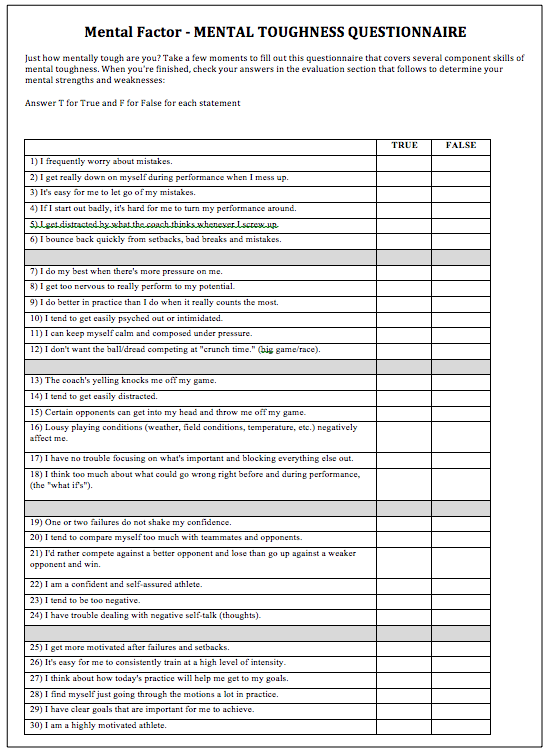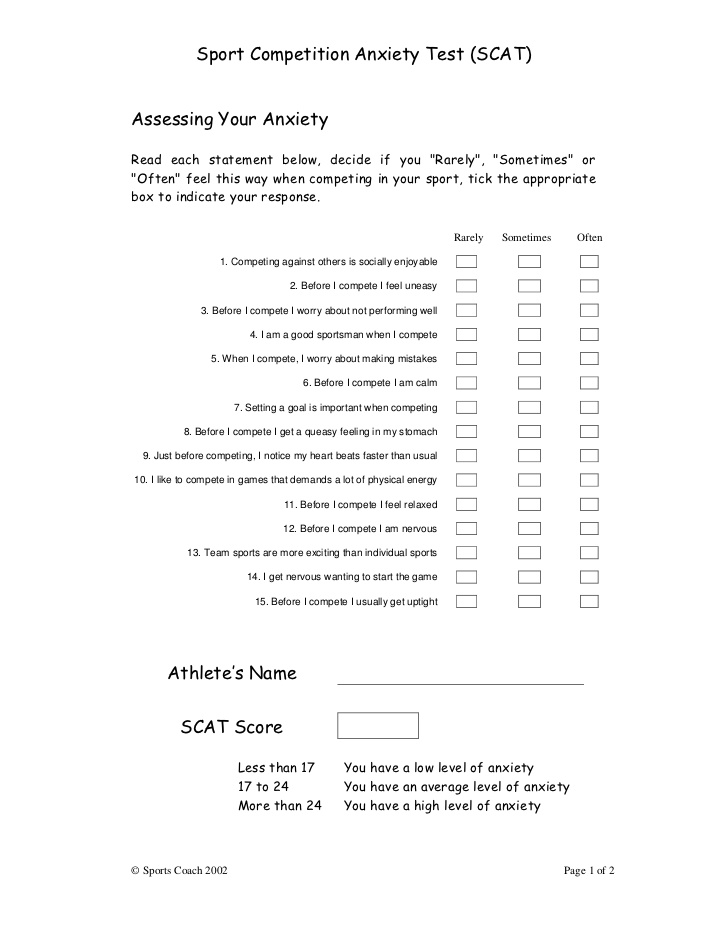Data Collection (Mental)
METHOD 1
PERFORMANCE PROFILING WHEEL
Sub-factors: can be applied to all mental sub-factors

Describe one method you could use to collect data on mental factors. (4).
KEY
Descriptive point 1
Descriptive point 2
Descriptive point 3
Descriptive point 4
‘A method I used to collect data on mental factors was the Performance Profiling Wheel (PPW).’
‘The PPW is a wheel arranged into 8 different sections with a mental sub-factor written on the outside of each section. Within each section, are 10 segments which represented a score of 1 (inside) – 10 (outside) with 1 being the poorest and 10 being the best.’
‘To begin with, I considered how the captain of my team (model performer) would score in each section and coloured in this segment in red. For e.g., if I thought their mental toughness was an 8, I coloured in the 8th segment in red. After doing this, I considered my capabilities in this section. If I scored myself a 4 for mental toughness, I coloured in segments 1-4 in blue. I then coloured in the rest of the segments up to 8 (model performer) in red. I then identified my strengths and weaknesses. A weakness was where red remained.’
NOTE:
The candidate has clearly made more than 4 points of description whilst achieving the 4 marks. Always do this to provide full answers and show the examiner that you are a pupil with high standards.
Explain why you could use this method to collect data on the mental factor. (4).
KEY:
Point of explanation
‘I used the PPW because it was practical as I was able to do it at home away from the training ground. This meant I took my time in completing the method as I was not rushed to go out and train and I therefore provided well thought out and valid responses.’
‘I also used the PPW because it was practical as it was very easy to interpret my data. This meant it was easy for me to accurately identify my strengths and weaknesses as I just looked for the colour red remaining in each section. This lead to me selecting the correct weak sub-factors and collecting more detailed data on why they were a weakness.’*
‘Another reason why I used the PPW was because it was practical as it was quick and easy to complete. This meant that I did not get bored in a long winded process and was able to really focus and give honest answers as I remained motivated.’
‘Finally, the PPW was selected because it was measurable as it was a permanent record. This meant I was able to compare my subsequent re-tests back to my initial data to measure my improvements. This then lead to me receiving a boost in confidence when I noticed my progress and enabled me to set even more challenging goals to ensure I did not plateau.’*
*Paragraphs 2 and 4 both contain what is referred to as a point of development. Having explained why the part of PARV(M) helped them select this method in sentence 2, a third sentence further explaining the impact this then had on the data collection process was identified. Consequently, although the question was out of 4, the candidate provided 6 points of explanation.
Analyse how suitable this method is in collecting data on the mental factor. (4).
KEY:
Point of analysis
‘It is important when using the PPW that you use a realistic model performer. This is because if you used an elite athlete such as Serena Williams, you may lose motivation and confidence as you will find that you are consistently marking yourself lower than them which can then lead to you giving up and not giving 100% in completing the method and your development plan.’
‘It is also important that you complete the PPW at home. This is because if you did it at the training ground, you may feel rushed by the coach to get out and train or you may feel embarrassed in completing the PPW in front of your teammates which can lead to you not taking it seriously and filling it out incorrectly.’
‘Another important thing to consider with the PPW is how honest you are in the process. This is because it uses purely subjective data which can mean you may lie to impress your coach meaning you therefore produce inaccurate data and do not begin an appropriate development plan to improve your performance.’
‘Finally, it is important that you scan the PPW and keep an electronic copy of it. This is because you will always have a second copy of your baseline data to refer back to even if you lose the initial sheet and will therefore be able to make valid measurements of your progress during your development plan.’
Evaluate how effective this method was in collecting data on the mental factor. (4).
KEY:
Evaluative point
‘The PPW was fairly effective in collecting data on mental factors.’
‘It was beneficial because it was practical as it was very easy to complete. This was good as I made very little errors in understanding what I had to do which meant I filled it out correctly and received valid data.’
‘It was also beneficial because it was practical as it was very easy to interpret my data. This was good as it meant I was able to clearly identify my mental strengths and weaknesses.’
‘However, the PPW was limited as it was not very appropriate in that it did not tell me why a sub-factor was weak. This was poor as I had to collect even more data to analyse this and I started to get bored and did not give this my full attention or effort leading to me having slightly questionable data.’
‘The PPW was also limited because I used an elite athlete as my model performer. This was poor as it meant that I quickly lost confidence as I found myself being much lower than them on every mental sub-factor and I therefore went into my development plan in a very negative state of mind.’
METHOD 2
MENTAL TOUGHNESS QUESTIONNAIRE
Sub-factors: concentration, confidence, mental toughness, motivation and resilience
Describe one method you could use to collect data on mental factors. (4).
KEY
Descriptive point 1
Descriptive point 2
Descriptive point 3
Descriptive point 4
‘The Mental Toughness Questionnaire is a method performers could use to collect data on mental factors (mental toughness).’
‘The questionnaire comes in the form of a table with 30 statements. These 30 statements are divided into 5 categories: reboundability, handling pressure, focus and concentration, confidence and motivation. Each of these categories has 6 statements. To the right of each statement are two columns: true and false.’
‘Performers would complete the questionnaire by reading each statement and placing a tick in either the true of false box to show how that statement relates to them. Each response is given a score of 1 or 0. After completing the questionnaire, these scores are added up and compared to the following NORMS provided on the back of the page: 26-30 would suggest that mental toughness is a strength; 23-25 would suggest moderate levels of mental toughness and 22 or below would suggest it is an area in need of development.’
NOTE:
The candidate has clearly made more than 4 points of description whilst achieving the 4 marks. Always do this to provide full answers and show the examiner that you are a pupil with high standards.
Explain why you could use this method to collect data on the mental factor. (4).
KEY:
Point of explanation
‘I used the Mental Toughness Questionnaire because it was practical as it was quick and easy to complete. This meant I did not lose interest in what was a quick process and therefore did not feel the need to rush my answers which meant they were well thought out and valid.’
‘I also used the Mental Toughness Questionnaire because it was practical as I was able to take it home and complete it there. This meant I got accurate results as I was totally honest due to not having a fear of embarrassment of doing it in front of my teammates in the dressing room.’
‘Another reason why I used the Mental Toughness Questionnaire was because it was valid as the statements were very easy to understand. This meant I did not misunderstand any statements and completed the process correctly.’
‘Finally, the Mental Toughness Questionnaire was used because it was measurable as it was a permanent record. This meant I had baseline information to compare my future re-tests to so I could measure my progress in the mental factor.’
Analyse how suitable this method is in collecting data on the mental factor. (4).
KEY:
Point of analysis
‘It is important when completing the Mental Toughness Questionnaire that you do it at home away from the training ground. This is because you will not feel rushed from your coach to go out and train which means you can take your time and provide well-thought out answers which can lead to you having valid data. Also, doing this at home means you will not feel embarrassed about putting potentially negative answers in front of watching teammates and can therefore allow you to be more honest in this process to help you produce more accurate and reliable results.’*
‘It is important that you are completely honest when completing the Mental Toughness Questionnaire. This is because only you know the answers to the statements as they are concerning how you feel and nobody else can support you in this process meaning your data is completely qualitative and the appropriateness of any future development plan relies on how honest you are in this process.’
‘Finally, it is important that you take an electronic copy of your Mental Toughness Questionnaire. This is because it will give you a back up copy should your initial sheet get lost meaning you will still have a permanent record of your baseline data to compare your results to which means comparisons of your progress will be valid and well-founded.’
*Notice how this answer only has 3 paragraphs despite it being a 4 mark question. This is because the candidate has made 2 different points of analysis within paragraph 1. Therefore, if you can provide different reasons why something is important within a method, then demonstrate this wider knowledge to the examiner.’
Evaluate how effective this method was in collecting data on the mental factor. (4).
KEY:
Evaluative point
‘The Mental Toughness Questionnaire was fairly effective in collecting data on the mental factor.’
‘One benefit of the Mental Toughness Questionnaire was that it was practical as it was quick and easy to complete. This was good as it meant I did not get bored in a long-drawn out process meaning I remained motivated throughout and took my time when giving valid responses.’
‘It was also beneficial as it was valid in that I found the statements easy to understand. This was good as it meant I fully understood each statement and was therefore able to answer it correctly.’
‘However, one limitation of the Mental Toughness Questionnaire was that the subjective nature of my responses could negatively effected the reliability of my results. This was poor as it meant on one statement I did deliberately lie as I knew my coach would see the answer and might therefore drop me from the team in high pressure matches. This therefore meant that my result was inaccurate and I did not incorporate it within my development plan which made it even worse as it was a weakness I could have done with correcting.’*
*Again, 3 paragraphs have been written in this answer despite it being a 4 mark question. This is because the candidate has made an evaluative point of development in the third paragraph as they have evaluated how the negative in sentence 2 further decreased the reliability of the data collection process in sentence 3.
METHOD 3
SPORTS COMPETITION ANXIETY TEST (SCAT)
Sub-factor: anxiety
Describe one method you could use to collect data on mental factors. (4).
KEY
Descriptive point 1
Descriptive point 2
Descriptive point 3
Descriptive point 4
‘One method I used to collect data on the mental factor (anxiety) was the Sports Competition Anxiety Test (SCAT).’
‘The SCAT had 15 statements in the form of a questionnaire. To the right of each statement were three potential responses: ‘rarely’, ‘sometimes’ and ‘often’. At the bottom of the sheet was a box for my SCAT score and a set of NORMS. Over the page there was a table which attributed a score to each answer I selected.’
‘I completed the SCAT immediately after a performance. I read each statement and placed a tick in the appropriate box. I then identified my score for each statement in the table over the page. I finished by adding up these scores and comparing my overall score to the NORMS and identifying my anxiety levels.’
NOTE:
The candidate has clearly made more than 4 points of description whilst achieving the 4 marks. Always do this to provide full answers and show the examiner that you are a pupil with high standards.
Explain why you could use this method to collect data on the mental factor. (4).
KEY:
Point of explanation
‘I chose the SCAT because it was practical as it was very easy to interpret my scores. This meant it was easy for me to identify my anxiety levels by comparing it to the NORMS and identifying if it was a strength or a weakness. This then lead to me using these NORMS to help me set a realistic and achievable target for my development plan.’*
‘I also chose the SCAT because it was appropriate as it is a scientifically recognised measurement of a performer’s anxiety levels. This meant I knew I received valid results as I followed the protocols correctly.’
‘Finally, I chose the SCAT because it was measurable as it was a permanent record. This meant I had baseline information to compare my re-tests to back to which made it easy for me to chart my progress. This then lead to me making changes to the approaches I was using when I saw that my progress was plateauing.’*
*Paragraphs 1 and 3 each contain points of development as the candidate has further explained how their initial justification in sentence 2 was also helpful in the data collection process. This can clarify why the candidate has only written 3 paragraphs for a 4 mark answer and can even be argued that they have made 5 points of explanation.
Analyse how suitable this method is in collecting data on the mental factor. (4).
KEY:
Point of analysis
‘It is important that you complete the SCAT immediately after a performance. This is because the thoughts and feelings will be fresh in your head which means you will be able to provide more accurate answers which can therefore ensure your results are more reliable.’
‘It is also important you are 100% honest when completing the SCAT. This is because all of the answers provided are your opinions meaning your data is qualitative which can open up the possibility of you lying to impress your coach which can then leave question marks over the reliability of your results.’
‘In addition to this, it is important that you ask a knowledgeable other such as a coach or teacher for clarification if you misunderstand any statement in the SCAT. This is because although the statements are fairly easy to understand, you may misinterpret what a statement means which can lead to you providing the wrong response which can lead to the validity of your results being questioned.’
‘Finally, it is important that you take a photocopy of your SCAT and/or scan it and save it electronically. This is because it will ensure you will always have a back up copy should your initial sheet get damaged which means you will always have your baseline information to compare future re-tests to which can help you make more informed and valid measurements of your progress.’
Evaluate how effective this method was in collecting data on the mental factor. (4).
KEY:
Evaluative point
‘The SCAT was fairly effective in collecting data on the mental factor.’
‘It was beneficial because it was practical as it was quick and easy to complete. This was good because I remained motivated in a quick data collection process which meant I tried to be very considerate of my response to each statement.’
‘It was also beneficial as it was appropriate as it provided me with NORMS to compare my overall score to. This was good because I found it very helpful in setting targets for my development plan which really boosted my motivation levels once I started training.’
‘Another benefit was that it was measurable as I had a permanent copy of my initial results. This was good as it made it easy for me to make comparisons of my re-tests to the baseline data and chart my progress during my plan.’
‘However, the validity of my data was not perfect as I did not complete it immediately after my performance. This was poor as my responses were often questionable as I could not remember exactly how I felt during matches because I completed it later on in the house.’
NOTE:
The candidate has justified their ‘fairly effective’ value by using a 3:1 split rather than a 2:2 one. This is fine as it still justifies this value and can allow you to be creative in your responses to evaluation questions.
NEXT STEPS:
Let’s now move on to the methods that could be used to collect data on the emotional factor.


